Marketing Essentials Report: Trends, Processes, and Departments
VerifiedAdded on 2021/08/10
|12
|3023
|49
Report
AI Summary
This report provides a comprehensive overview of marketing essentials, encompassing its definition, core concepts, and the analysis of current and future trends. It delves into the marketing process, outlining its various stages, from understanding customer needs to creating and capturing customer value. The report also examines the importance of marketing directors and managers within an organization, highlighting their roles and responsibilities. Furthermore, it explores the interrelationship between the marketing department and other functional departments, such as sales, finance, human resources, production, customer service, and logistics. The report emphasizes the significance of marketing in increasing sales, gaining a competitive advantage, building brand value, and fostering customer relationships, ultimately underlining the critical role of marketing in organizational success.
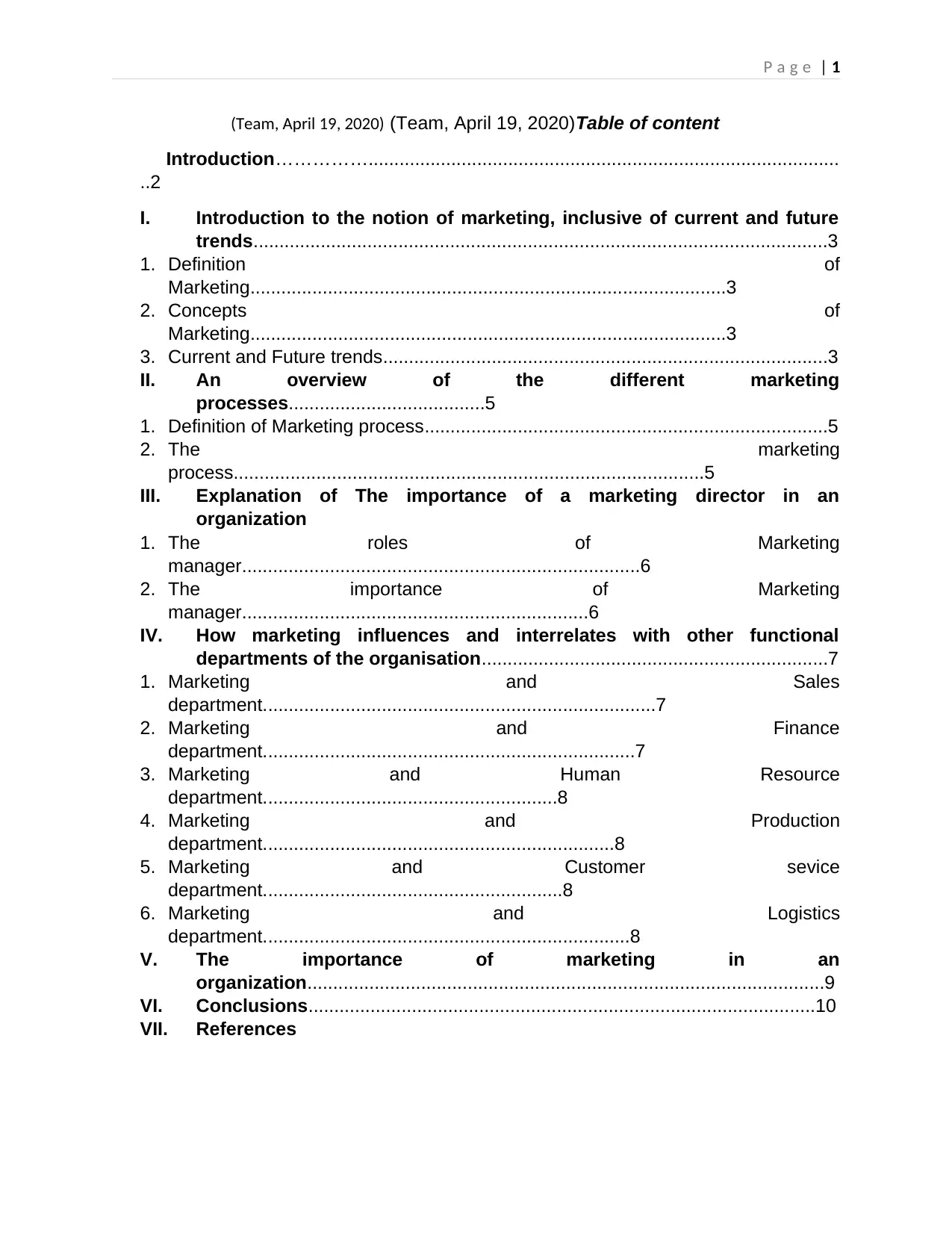
P a g e | 1
(Team, April 19, 2020) (Team, April 19, 2020)Table of content
Introduction……………...........................................................................................
..2
I. Introduction to the notion of marketing, inclusive of current and future
trends...............................................................................................................3
1. Definition of
Marketing............................................................................................3
2. Concepts of
Marketing............................................................................................3
3. Current and Future trends......................................................................................3
II. An overview of the different marketing
processes......................................5
1. Definition of Marketing process..............................................................................5
2. The marketing
process...........................................................................................5
III. Explanation of The importance of a marketing director in an
organization
1. The roles of Marketing
manager.............................................................................6
2. The importance of Marketing
manager...................................................................6
IV. How marketing influences and interrelates with other functional
departments of the organisation...................................................................7
1. Marketing and Sales
department............................................................................7
2. Marketing and Finance
department........................................................................7
3. Marketing and Human Resource
department.........................................................8
4. Marketing and Production
department....................................................................8
5. Marketing and Customer sevice
department..........................................................8
6. Marketing and Logistics
department.......................................................................8
V. The importance of marketing in an
organization....................................................................................................9
VI. Conclusions..................................................................................................10
VII. References
(Team, April 19, 2020) (Team, April 19, 2020)Table of content
Introduction……………...........................................................................................
..2
I. Introduction to the notion of marketing, inclusive of current and future
trends...............................................................................................................3
1. Definition of
Marketing............................................................................................3
2. Concepts of
Marketing............................................................................................3
3. Current and Future trends......................................................................................3
II. An overview of the different marketing
processes......................................5
1. Definition of Marketing process..............................................................................5
2. The marketing
process...........................................................................................5
III. Explanation of The importance of a marketing director in an
organization
1. The roles of Marketing
manager.............................................................................6
2. The importance of Marketing
manager...................................................................6
IV. How marketing influences and interrelates with other functional
departments of the organisation...................................................................7
1. Marketing and Sales
department............................................................................7
2. Marketing and Finance
department........................................................................7
3. Marketing and Human Resource
department.........................................................8
4. Marketing and Production
department....................................................................8
5. Marketing and Customer sevice
department..........................................................8
6. Marketing and Logistics
department.......................................................................8
V. The importance of marketing in an
organization....................................................................................................9
VI. Conclusions..................................................................................................10
VII. References
Paraphrase This Document
Need a fresh take? Get an instant paraphrase of this document with our AI Paraphraser

P a g e | 2
4.
4.
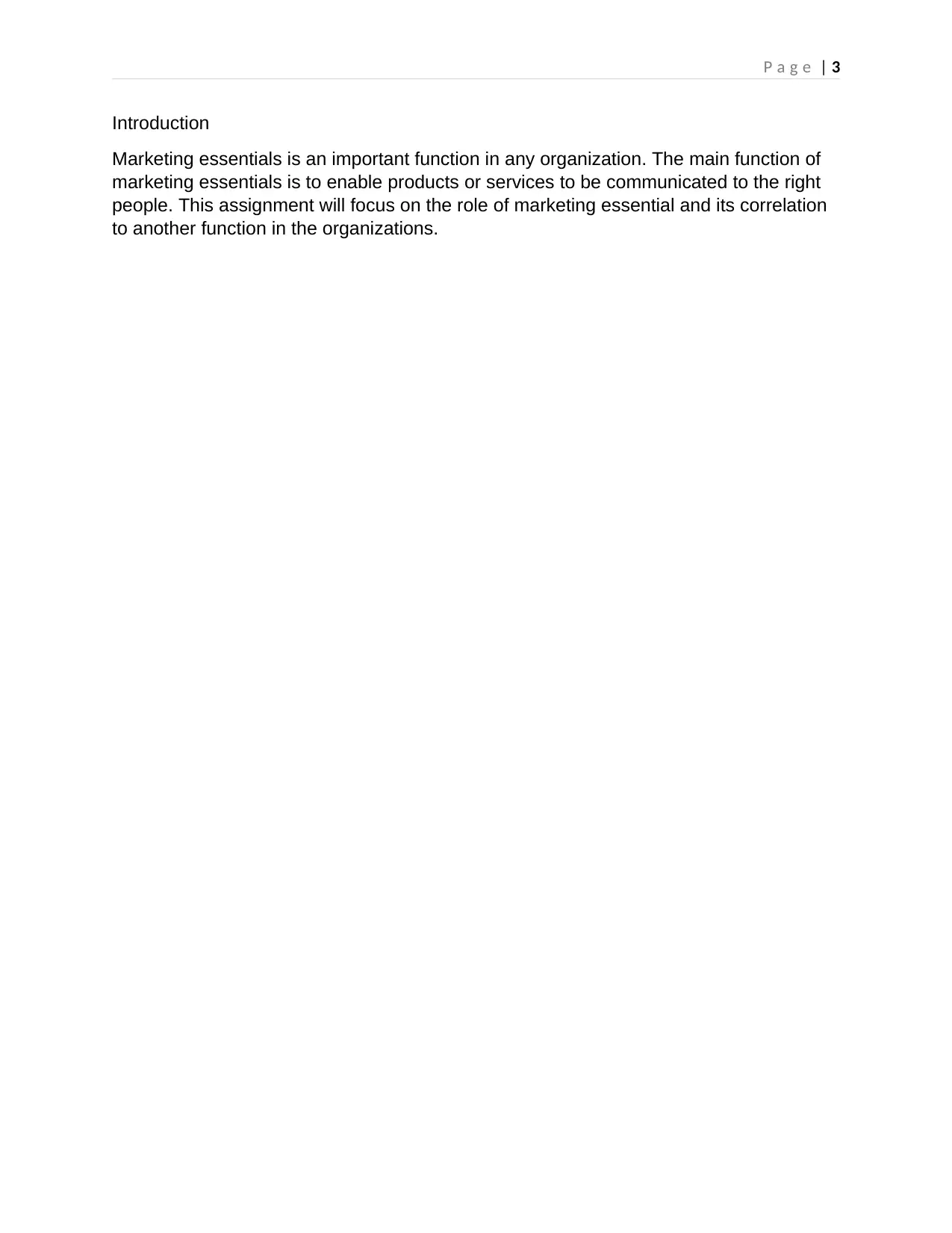
P a g e | 3
Introduction
Marketing essentials is an important function in any organization. The main function of
marketing essentials is to enable products or services to be communicated to the right
people. This assignment will focus on the role of marketing essential and its correlation
to another function in the organizations.
Introduction
Marketing essentials is an important function in any organization. The main function of
marketing essentials is to enable products or services to be communicated to the right
people. This assignment will focus on the role of marketing essential and its correlation
to another function in the organizations.
⊘ This is a preview!⊘
Do you want full access?
Subscribe today to unlock all pages.

Trusted by 1+ million students worldwide
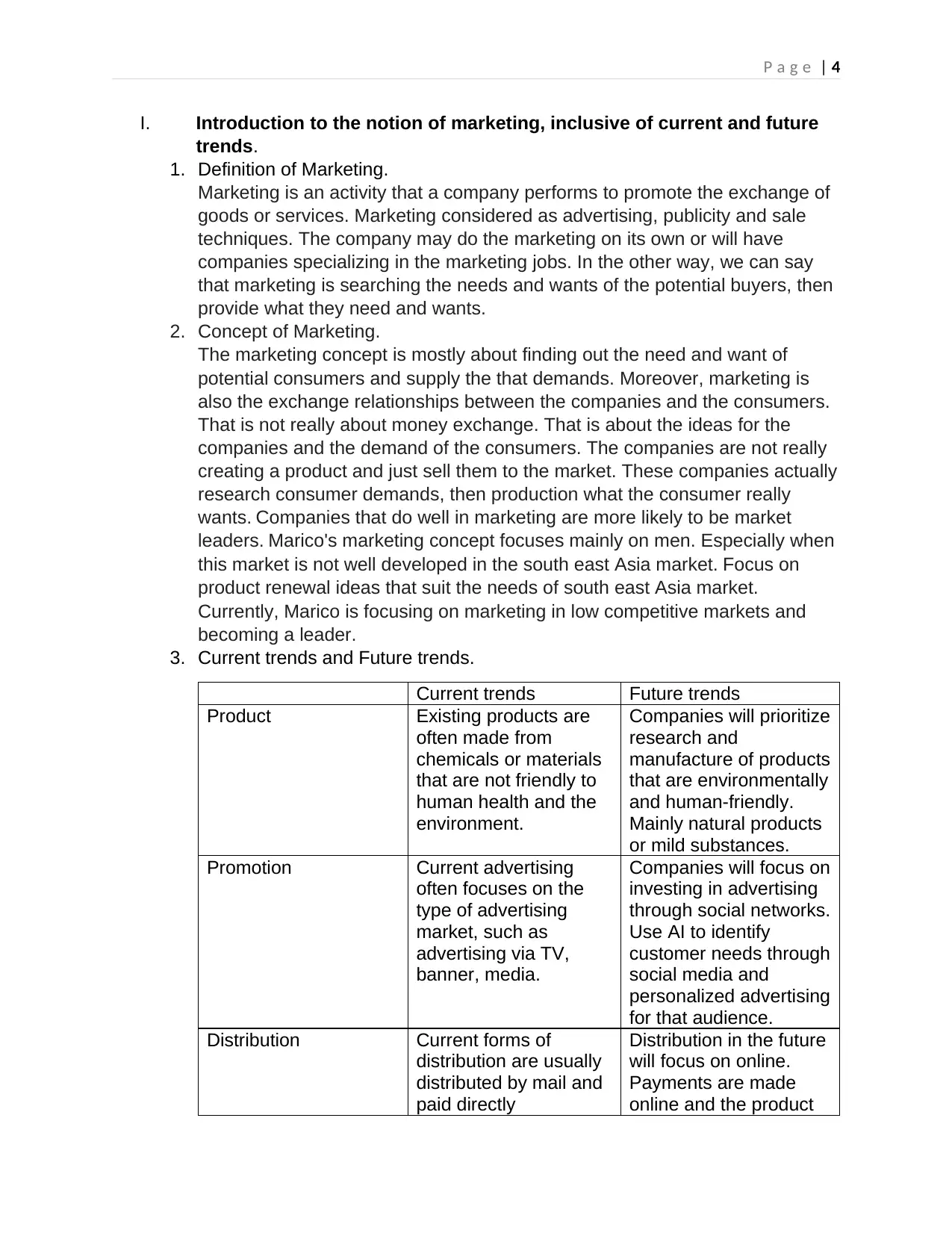
P a g e | 4
I. Introduction to the notion of marketing, inclusive of current and future
trends.
1. Definition of Marketing.
Marketing is an activity that a company performs to promote the exchange of
goods or services. Marketing considered as advertising, publicity and sale
techniques. The company may do the marketing on its own or will have
companies specializing in the marketing jobs. In the other way, we can say
that marketing is searching the needs and wants of the potential buyers, then
provide what they need and wants.
2. Concept of Marketing.
The marketing concept is mostly about finding out the need and want of
potential consumers and supply the that demands. Moreover, marketing is
also the exchange relationships between the companies and the consumers.
That is not really about money exchange. That is about the ideas for the
companies and the demand of the consumers. The companies are not really
creating a product and just sell them to the market. These companies actually
research consumer demands, then production what the consumer really
wants. Companies that do well in marketing are more likely to be market
leaders. Marico's marketing concept focuses mainly on men. Especially when
this market is not well developed in the south east Asia market. Focus on
product renewal ideas that suit the needs of south east Asia market.
Currently, Marico is focusing on marketing in low competitive markets and
becoming a leader.
3. Current trends and Future trends.
Current trends Future trends
Product Existing products are
often made from
chemicals or materials
that are not friendly to
human health and the
environment.
Companies will prioritize
research and
manufacture of products
that are environmentally
and human-friendly.
Mainly natural products
or mild substances.
Promotion Current advertising
often focuses on the
type of advertising
market, such as
advertising via TV,
banner, media.
Companies will focus on
investing in advertising
through social networks.
Use AI to identify
customer needs through
social media and
personalized advertising
for that audience.
Distribution Current forms of
distribution are usually
distributed by mail and
paid directly
Distribution in the future
will focus on online.
Payments are made
online and the product
I. Introduction to the notion of marketing, inclusive of current and future
trends.
1. Definition of Marketing.
Marketing is an activity that a company performs to promote the exchange of
goods or services. Marketing considered as advertising, publicity and sale
techniques. The company may do the marketing on its own or will have
companies specializing in the marketing jobs. In the other way, we can say
that marketing is searching the needs and wants of the potential buyers, then
provide what they need and wants.
2. Concept of Marketing.
The marketing concept is mostly about finding out the need and want of
potential consumers and supply the that demands. Moreover, marketing is
also the exchange relationships between the companies and the consumers.
That is not really about money exchange. That is about the ideas for the
companies and the demand of the consumers. The companies are not really
creating a product and just sell them to the market. These companies actually
research consumer demands, then production what the consumer really
wants. Companies that do well in marketing are more likely to be market
leaders. Marico's marketing concept focuses mainly on men. Especially when
this market is not well developed in the south east Asia market. Focus on
product renewal ideas that suit the needs of south east Asia market.
Currently, Marico is focusing on marketing in low competitive markets and
becoming a leader.
3. Current trends and Future trends.
Current trends Future trends
Product Existing products are
often made from
chemicals or materials
that are not friendly to
human health and the
environment.
Companies will prioritize
research and
manufacture of products
that are environmentally
and human-friendly.
Mainly natural products
or mild substances.
Promotion Current advertising
often focuses on the
type of advertising
market, such as
advertising via TV,
banner, media.
Companies will focus on
investing in advertising
through social networks.
Use AI to identify
customer needs through
social media and
personalized advertising
for that audience.
Distribution Current forms of
distribution are usually
distributed by mail and
paid directly
Distribution in the future
will focus on online.
Payments are made
online and the product
Paraphrase This Document
Need a fresh take? Get an instant paraphrase of this document with our AI Paraphraser

P a g e | 5
is delivered to the
buyer's home.
Price Of course, the support
services are not good
at this time, so the
price will also be low.
the service is good so
the price will be
somewhat higher.
is delivered to the
buyer's home.
Price Of course, the support
services are not good
at this time, so the
price will also be low.
the service is good so
the price will be
somewhat higher.
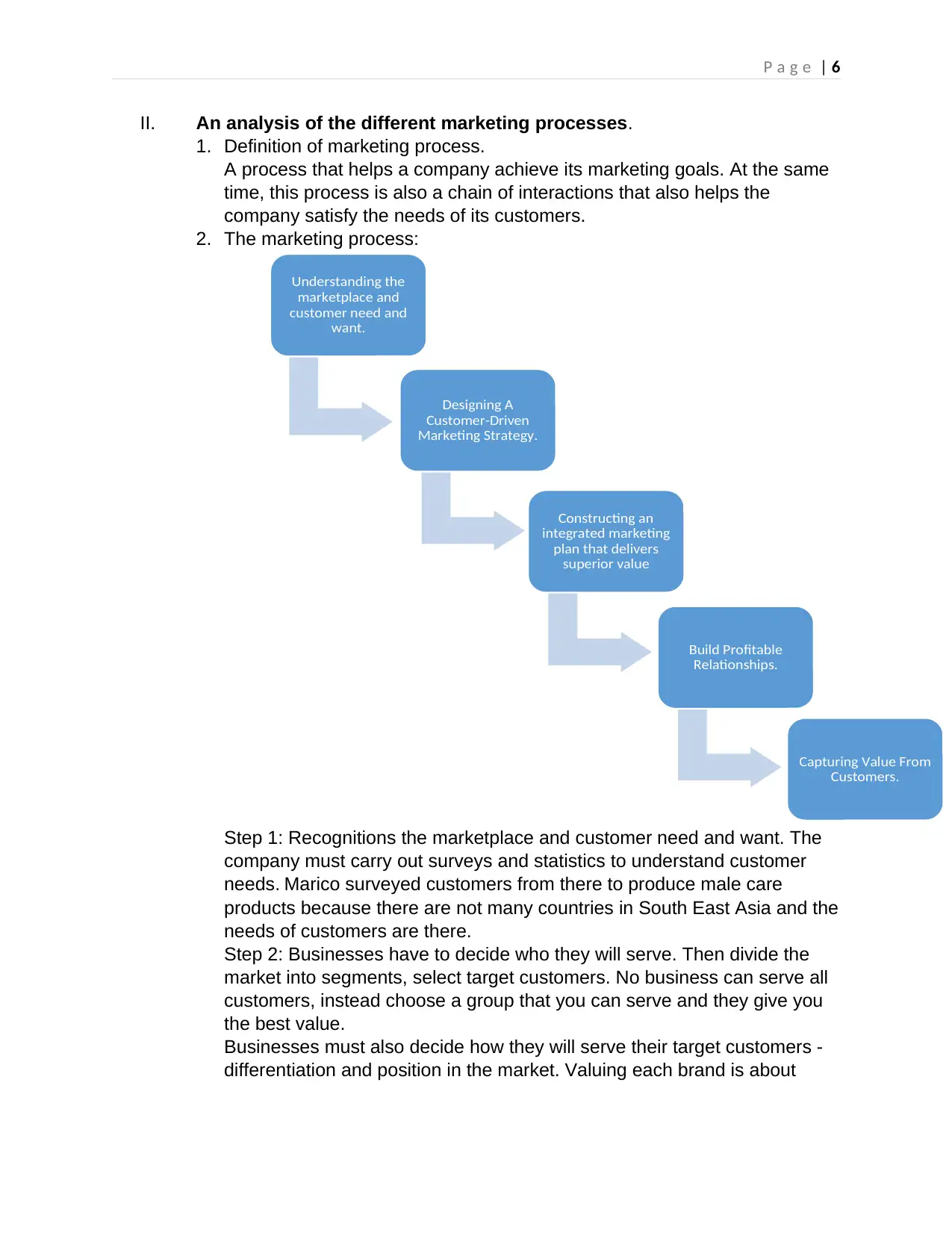
P a g e | 6
II. An analysis of the different marketing processes.
1. Definition of marketing process.
A process that helps a company achieve its marketing goals. At the same
time, this process is also a chain of interactions that also helps the
company satisfy the needs of its customers.
2. The marketing process:
Step 1: Recognitions the marketplace and customer need and want. The
company must carry out surveys and statistics to understand customer
needs. Marico surveyed customers from there to produce male care
products because there are not many countries in South East Asia and the
needs of customers are there.
Step 2: Businesses have to decide who they will serve. Then divide the
market into segments, select target customers. No business can serve all
customers, instead choose a group that you can serve and they give you
the best value.
Businesses must also decide how they will serve their target customers -
differentiation and position in the market. Valuing each brand is about
Understanding the
marketplace and
customer need and
want.
Designing A
Customer-Driven
Marketing Strategy.
Constructing an
integrated marketing
plan that delivers
superior value
Build Profitable
Relationships.
Capturing Value From
Customers.
II. An analysis of the different marketing processes.
1. Definition of marketing process.
A process that helps a company achieve its marketing goals. At the same
time, this process is also a chain of interactions that also helps the
company satisfy the needs of its customers.
2. The marketing process:
Step 1: Recognitions the marketplace and customer need and want. The
company must carry out surveys and statistics to understand customer
needs. Marico surveyed customers from there to produce male care
products because there are not many countries in South East Asia and the
needs of customers are there.
Step 2: Businesses have to decide who they will serve. Then divide the
market into segments, select target customers. No business can serve all
customers, instead choose a group that you can serve and they give you
the best value.
Businesses must also decide how they will serve their target customers -
differentiation and position in the market. Valuing each brand is about
Understanding the
marketplace and
customer need and
want.
Designing A
Customer-Driven
Marketing Strategy.
Constructing an
integrated marketing
plan that delivers
superior value
Build Profitable
Relationships.
Capturing Value From
Customers.
⊘ This is a preview!⊘
Do you want full access?
Subscribe today to unlock all pages.

Trusted by 1+ million students worldwide
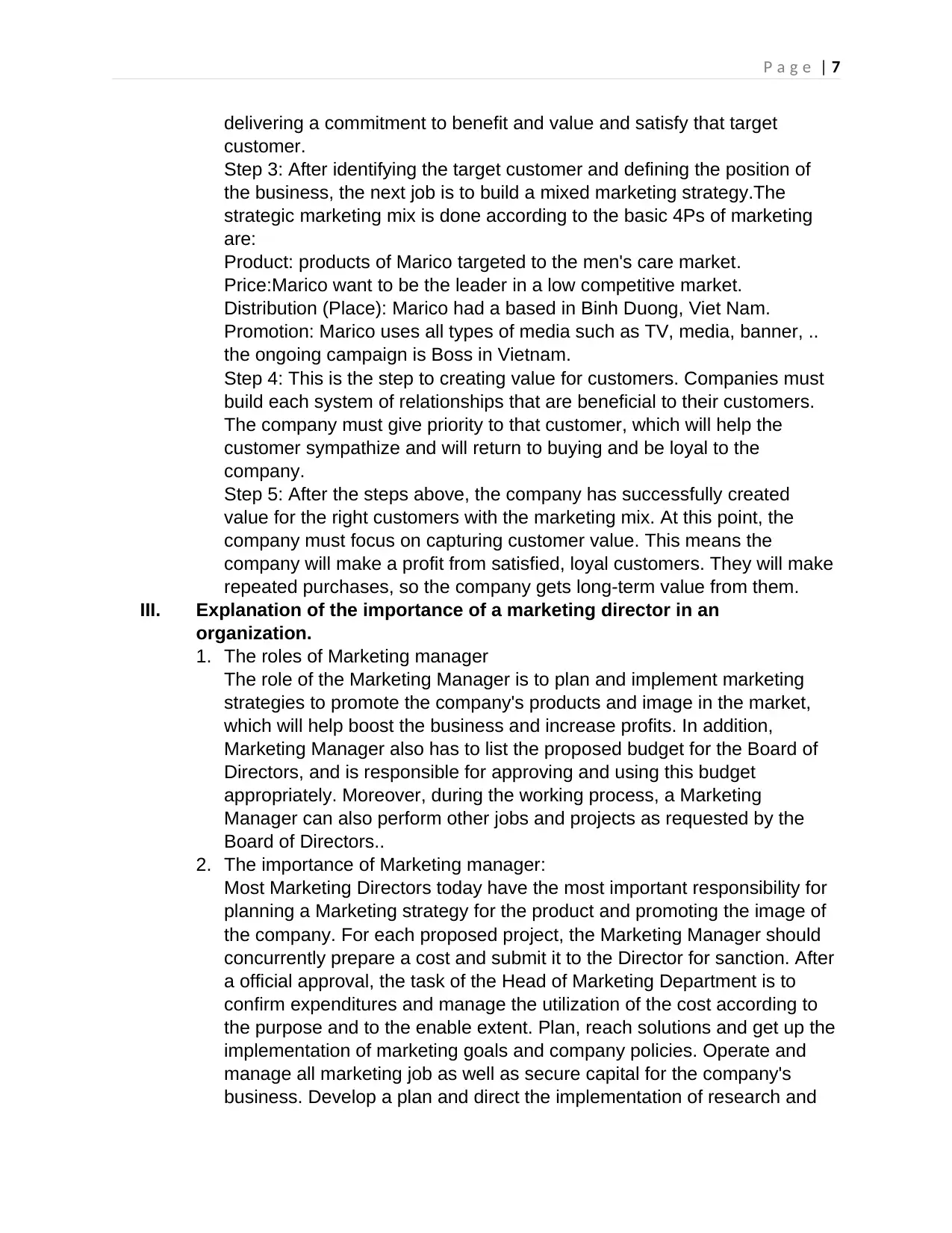
P a g e | 7
delivering a commitment to benefit and value and satisfy that target
customer.
Step 3: After identifying the target customer and defining the position of
the business, the next job is to build a mixed marketing strategy.The
strategic marketing mix is done according to the basic 4Ps of marketing
are:
Product: products of Marico targeted to the men's care market.
Price:Marico want to be the leader in a low competitive market.
Distribution (Place): Marico had a based in Binh Duong, Viet Nam.
Promotion: Marico uses all types of media such as TV, media, banner, ..
the ongoing campaign is Boss in Vietnam.
Step 4: This is the step to creating value for customers. Companies must
build each system of relationships that are beneficial to their customers.
The company must give priority to that customer, which will help the
customer sympathize and will return to buying and be loyal to the
company.
Step 5: After the steps above, the company has successfully created
value for the right customers with the marketing mix. At this point, the
company must focus on capturing customer value. This means the
company will make a profit from satisfied, loyal customers. They will make
repeated purchases, so the company gets long-term value from them.
III. Explanation of the importance of a marketing director in an
organization.
1. The roles of Marketing manager
The role of the Marketing Manager is to plan and implement marketing
strategies to promote the company's products and image in the market,
which will help boost the business and increase profits. In addition,
Marketing Manager also has to list the proposed budget for the Board of
Directors, and is responsible for approving and using this budget
appropriately. Moreover, during the working process, a Marketing
Manager can also perform other jobs and projects as requested by the
Board of Directors..
2. The importance of Marketing manager:
Most Marketing Directors today have the most important responsibility for
planning a Marketing strategy for the product and promoting the image of
the company. For each proposed project, the Marketing Manager should
concurrently prepare a cost and submit it to the Director for sanction. After
a official approval, the task of the Head of Marketing Department is to
confirm expenditures and manage the utilization of the cost according to
the purpose and to the enable extent. Plan, reach solutions and get up the
implementation of marketing goals and company policies. Operate and
manage all marketing job as well as secure capital for the company's
business. Develop a plan and direct the implementation of research and
delivering a commitment to benefit and value and satisfy that target
customer.
Step 3: After identifying the target customer and defining the position of
the business, the next job is to build a mixed marketing strategy.The
strategic marketing mix is done according to the basic 4Ps of marketing
are:
Product: products of Marico targeted to the men's care market.
Price:Marico want to be the leader in a low competitive market.
Distribution (Place): Marico had a based in Binh Duong, Viet Nam.
Promotion: Marico uses all types of media such as TV, media, banner, ..
the ongoing campaign is Boss in Vietnam.
Step 4: This is the step to creating value for customers. Companies must
build each system of relationships that are beneficial to their customers.
The company must give priority to that customer, which will help the
customer sympathize and will return to buying and be loyal to the
company.
Step 5: After the steps above, the company has successfully created
value for the right customers with the marketing mix. At this point, the
company must focus on capturing customer value. This means the
company will make a profit from satisfied, loyal customers. They will make
repeated purchases, so the company gets long-term value from them.
III. Explanation of the importance of a marketing director in an
organization.
1. The roles of Marketing manager
The role of the Marketing Manager is to plan and implement marketing
strategies to promote the company's products and image in the market,
which will help boost the business and increase profits. In addition,
Marketing Manager also has to list the proposed budget for the Board of
Directors, and is responsible for approving and using this budget
appropriately. Moreover, during the working process, a Marketing
Manager can also perform other jobs and projects as requested by the
Board of Directors..
2. The importance of Marketing manager:
Most Marketing Directors today have the most important responsibility for
planning a Marketing strategy for the product and promoting the image of
the company. For each proposed project, the Marketing Manager should
concurrently prepare a cost and submit it to the Director for sanction. After
a official approval, the task of the Head of Marketing Department is to
confirm expenditures and manage the utilization of the cost according to
the purpose and to the enable extent. Plan, reach solutions and get up the
implementation of marketing goals and company policies. Operate and
manage all marketing job as well as secure capital for the company's
business. Develop a plan and direct the implementation of research and
Paraphrase This Document
Need a fresh take? Get an instant paraphrase of this document with our AI Paraphraser
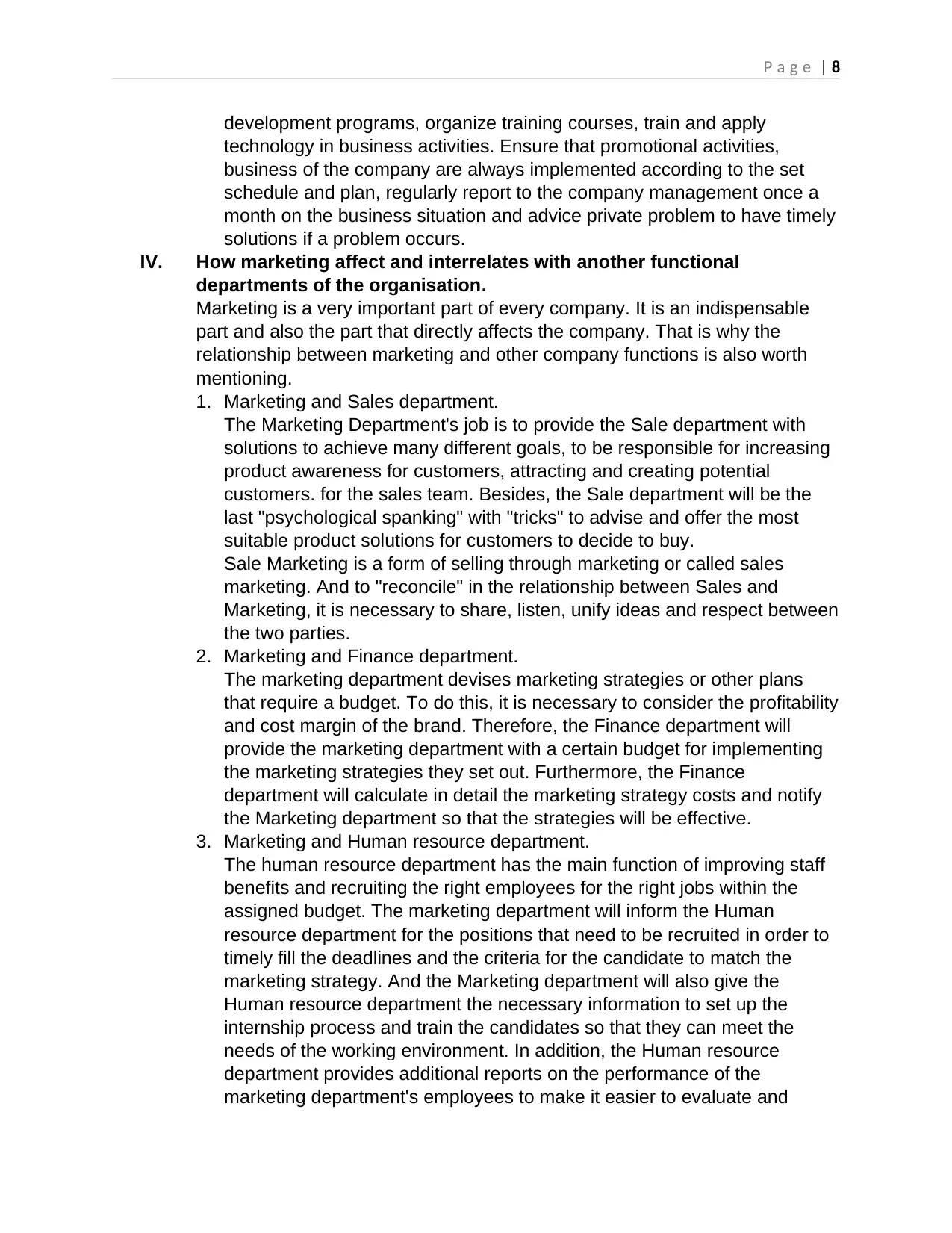
P a g e | 8
development programs, organize training courses, train and apply
technology in business activities. Ensure that promotional activities,
business of the company are always implemented according to the set
schedule and plan, regularly report to the company management once a
month on the business situation and advice private problem to have timely
solutions if a problem occurs.
IV. How marketing affect and interrelates with another functional
departments of the organisation.
Marketing is a very important part of every company. It is an indispensable
part and also the part that directly affects the company. That is why the
relationship between marketing and other company functions is also worth
mentioning.
1. Marketing and Sales department.
The Marketing Department's job is to provide the Sale department with
solutions to achieve many different goals, to be responsible for increasing
product awareness for customers, attracting and creating potential
customers. for the sales team. Besides, the Sale department will be the
last "psychological spanking" with "tricks" to advise and offer the most
suitable product solutions for customers to decide to buy.
Sale Marketing is a form of selling through marketing or called sales
marketing. And to "reconcile" in the relationship between Sales and
Marketing, it is necessary to share, listen, unify ideas and respect between
the two parties.
2. Marketing and Finance department.
The marketing department devises marketing strategies or other plans
that require a budget. To do this, it is necessary to consider the profitability
and cost margin of the brand. Therefore, the Finance department will
provide the marketing department with a certain budget for implementing
the marketing strategies they set out. Furthermore, the Finance
department will calculate in detail the marketing strategy costs and notify
the Marketing department so that the strategies will be effective.
3. Marketing and Human resource department.
The human resource department has the main function of improving staff
benefits and recruiting the right employees for the right jobs within the
assigned budget. The marketing department will inform the Human
resource department for the positions that need to be recruited in order to
timely fill the deadlines and the criteria for the candidate to match the
marketing strategy. And the Marketing department will also give the
Human resource department the necessary information to set up the
internship process and train the candidates so that they can meet the
needs of the working environment. In addition, the Human resource
department provides additional reports on the performance of the
marketing department's employees to make it easier to evaluate and
development programs, organize training courses, train and apply
technology in business activities. Ensure that promotional activities,
business of the company are always implemented according to the set
schedule and plan, regularly report to the company management once a
month on the business situation and advice private problem to have timely
solutions if a problem occurs.
IV. How marketing affect and interrelates with another functional
departments of the organisation.
Marketing is a very important part of every company. It is an indispensable
part and also the part that directly affects the company. That is why the
relationship between marketing and other company functions is also worth
mentioning.
1. Marketing and Sales department.
The Marketing Department's job is to provide the Sale department with
solutions to achieve many different goals, to be responsible for increasing
product awareness for customers, attracting and creating potential
customers. for the sales team. Besides, the Sale department will be the
last "psychological spanking" with "tricks" to advise and offer the most
suitable product solutions for customers to decide to buy.
Sale Marketing is a form of selling through marketing or called sales
marketing. And to "reconcile" in the relationship between Sales and
Marketing, it is necessary to share, listen, unify ideas and respect between
the two parties.
2. Marketing and Finance department.
The marketing department devises marketing strategies or other plans
that require a budget. To do this, it is necessary to consider the profitability
and cost margin of the brand. Therefore, the Finance department will
provide the marketing department with a certain budget for implementing
the marketing strategies they set out. Furthermore, the Finance
department will calculate in detail the marketing strategy costs and notify
the Marketing department so that the strategies will be effective.
3. Marketing and Human resource department.
The human resource department has the main function of improving staff
benefits and recruiting the right employees for the right jobs within the
assigned budget. The marketing department will inform the Human
resource department for the positions that need to be recruited in order to
timely fill the deadlines and the criteria for the candidate to match the
marketing strategy. And the Marketing department will also give the
Human resource department the necessary information to set up the
internship process and train the candidates so that they can meet the
needs of the working environment. In addition, the Human resource
department provides additional reports on the performance of the
marketing department's employees to make it easier to evaluate and
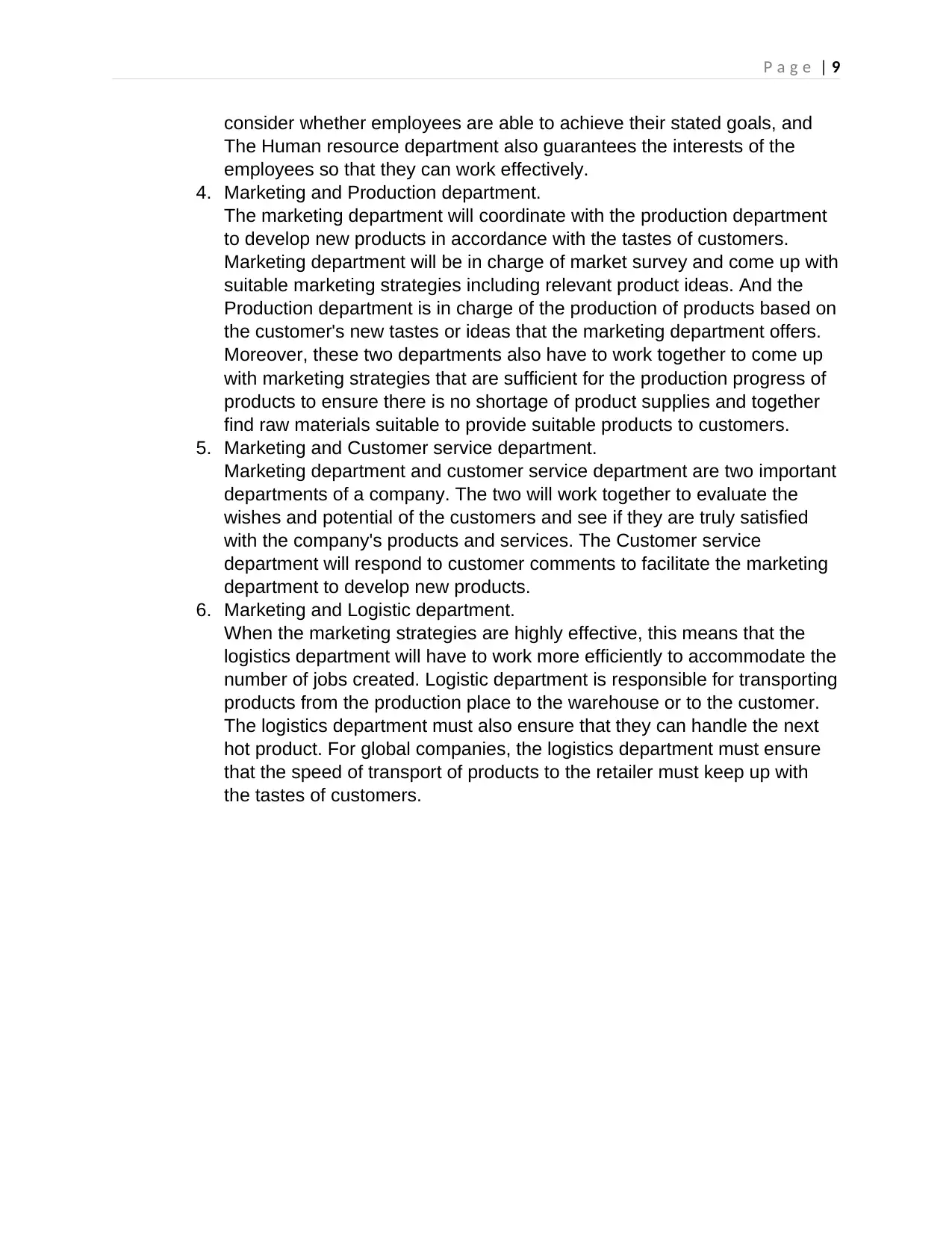
P a g e | 9
consider whether employees are able to achieve their stated goals, and
The Human resource department also guarantees the interests of the
employees so that they can work effectively.
4. Marketing and Production department.
The marketing department will coordinate with the production department
to develop new products in accordance with the tastes of customers.
Marketing department will be in charge of market survey and come up with
suitable marketing strategies including relevant product ideas. And the
Production department is in charge of the production of products based on
the customer's new tastes or ideas that the marketing department offers.
Moreover, these two departments also have to work together to come up
with marketing strategies that are sufficient for the production progress of
products to ensure there is no shortage of product supplies and together
find raw materials suitable to provide suitable products to customers.
5. Marketing and Customer service department.
Marketing department and customer service department are two important
departments of a company. The two will work together to evaluate the
wishes and potential of the customers and see if they are truly satisfied
with the company's products and services. The Customer service
department will respond to customer comments to facilitate the marketing
department to develop new products.
6. Marketing and Logistic department.
When the marketing strategies are highly effective, this means that the
logistics department will have to work more efficiently to accommodate the
number of jobs created. Logistic department is responsible for transporting
products from the production place to the warehouse or to the customer.
The logistics department must also ensure that they can handle the next
hot product. For global companies, the logistics department must ensure
that the speed of transport of products to the retailer must keep up with
the tastes of customers.
consider whether employees are able to achieve their stated goals, and
The Human resource department also guarantees the interests of the
employees so that they can work effectively.
4. Marketing and Production department.
The marketing department will coordinate with the production department
to develop new products in accordance with the tastes of customers.
Marketing department will be in charge of market survey and come up with
suitable marketing strategies including relevant product ideas. And the
Production department is in charge of the production of products based on
the customer's new tastes or ideas that the marketing department offers.
Moreover, these two departments also have to work together to come up
with marketing strategies that are sufficient for the production progress of
products to ensure there is no shortage of product supplies and together
find raw materials suitable to provide suitable products to customers.
5. Marketing and Customer service department.
Marketing department and customer service department are two important
departments of a company. The two will work together to evaluate the
wishes and potential of the customers and see if they are truly satisfied
with the company's products and services. The Customer service
department will respond to customer comments to facilitate the marketing
department to develop new products.
6. Marketing and Logistic department.
When the marketing strategies are highly effective, this means that the
logistics department will have to work more efficiently to accommodate the
number of jobs created. Logistic department is responsible for transporting
products from the production place to the warehouse or to the customer.
The logistics department must also ensure that they can handle the next
hot product. For global companies, the logistics department must ensure
that the speed of transport of products to the retailer must keep up with
the tastes of customers.
⊘ This is a preview!⊘
Do you want full access?
Subscribe today to unlock all pages.

Trusted by 1+ million students worldwide
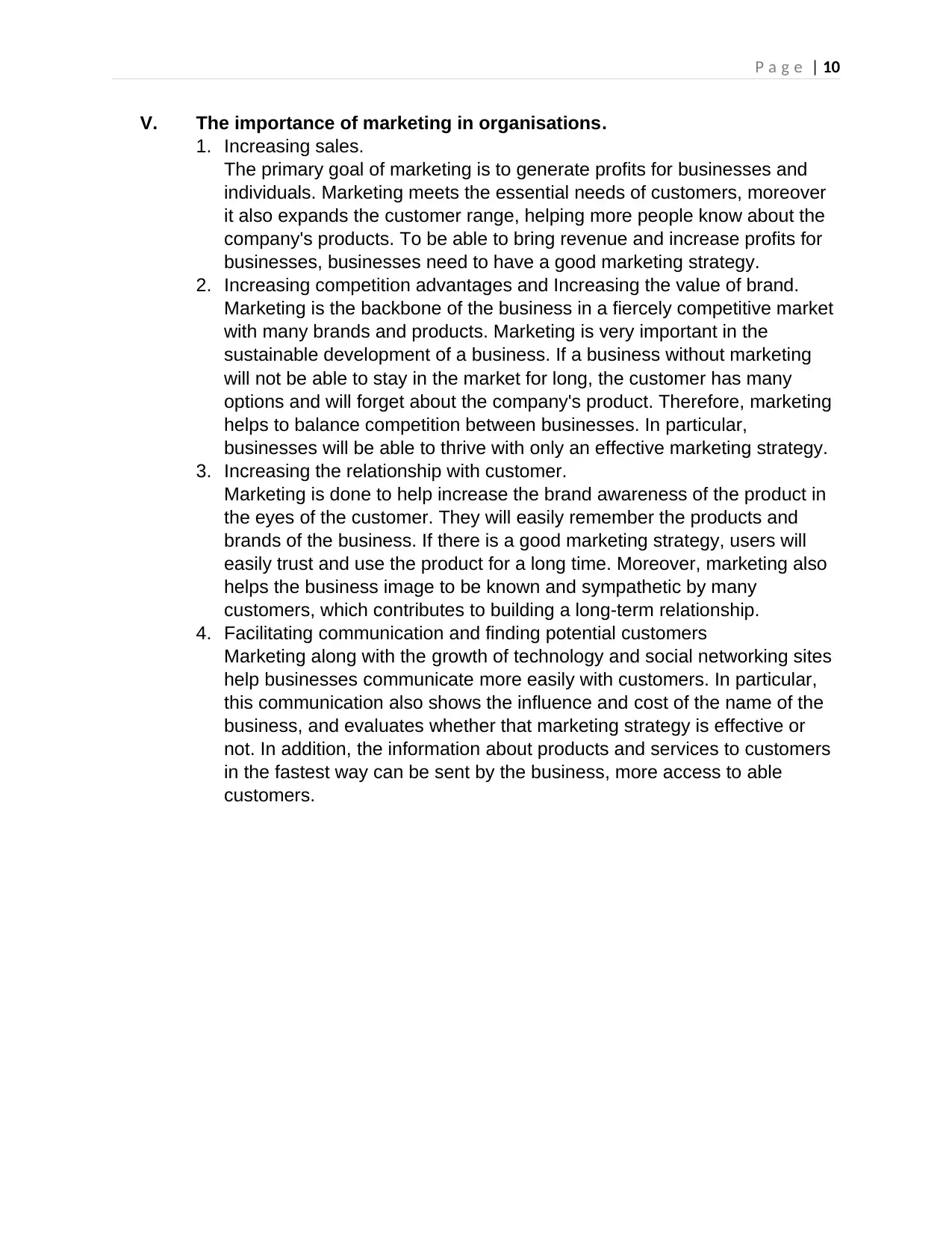
P a g e | 10
V. The importance of marketing in organisations.
1. Increasing sales.
The primary goal of marketing is to generate profits for businesses and
individuals. Marketing meets the essential needs of customers, moreover
it also expands the customer range, helping more people know about the
company's products. To be able to bring revenue and increase profits for
businesses, businesses need to have a good marketing strategy.
2. Increasing competition advantages and Increasing the value of brand.
Marketing is the backbone of the business in a fiercely competitive market
with many brands and products. Marketing is very important in the
sustainable development of a business. If a business without marketing
will not be able to stay in the market for long, the customer has many
options and will forget about the company's product. Therefore, marketing
helps to balance competition between businesses. In particular,
businesses will be able to thrive with only an effective marketing strategy.
3. Increasing the relationship with customer.
Marketing is done to help increase the brand awareness of the product in
the eyes of the customer. They will easily remember the products and
brands of the business. If there is a good marketing strategy, users will
easily trust and use the product for a long time. Moreover, marketing also
helps the business image to be known and sympathetic by many
customers, which contributes to building a long-term relationship.
4. Facilitating communication and finding potential customers
Marketing along with the growth of technology and social networking sites
help businesses communicate more easily with customers. In particular,
this communication also shows the influence and cost of the name of the
business, and evaluates whether that marketing strategy is effective or
not. In addition, the information about products and services to customers
in the fastest way can be sent by the business, more access to able
customers.
V. The importance of marketing in organisations.
1. Increasing sales.
The primary goal of marketing is to generate profits for businesses and
individuals. Marketing meets the essential needs of customers, moreover
it also expands the customer range, helping more people know about the
company's products. To be able to bring revenue and increase profits for
businesses, businesses need to have a good marketing strategy.
2. Increasing competition advantages and Increasing the value of brand.
Marketing is the backbone of the business in a fiercely competitive market
with many brands and products. Marketing is very important in the
sustainable development of a business. If a business without marketing
will not be able to stay in the market for long, the customer has many
options and will forget about the company's product. Therefore, marketing
helps to balance competition between businesses. In particular,
businesses will be able to thrive with only an effective marketing strategy.
3. Increasing the relationship with customer.
Marketing is done to help increase the brand awareness of the product in
the eyes of the customer. They will easily remember the products and
brands of the business. If there is a good marketing strategy, users will
easily trust and use the product for a long time. Moreover, marketing also
helps the business image to be known and sympathetic by many
customers, which contributes to building a long-term relationship.
4. Facilitating communication and finding potential customers
Marketing along with the growth of technology and social networking sites
help businesses communicate more easily with customers. In particular,
this communication also shows the influence and cost of the name of the
business, and evaluates whether that marketing strategy is effective or
not. In addition, the information about products and services to customers
in the fastest way can be sent by the business, more access to able
customers.
Paraphrase This Document
Need a fresh take? Get an instant paraphrase of this document with our AI Paraphraser
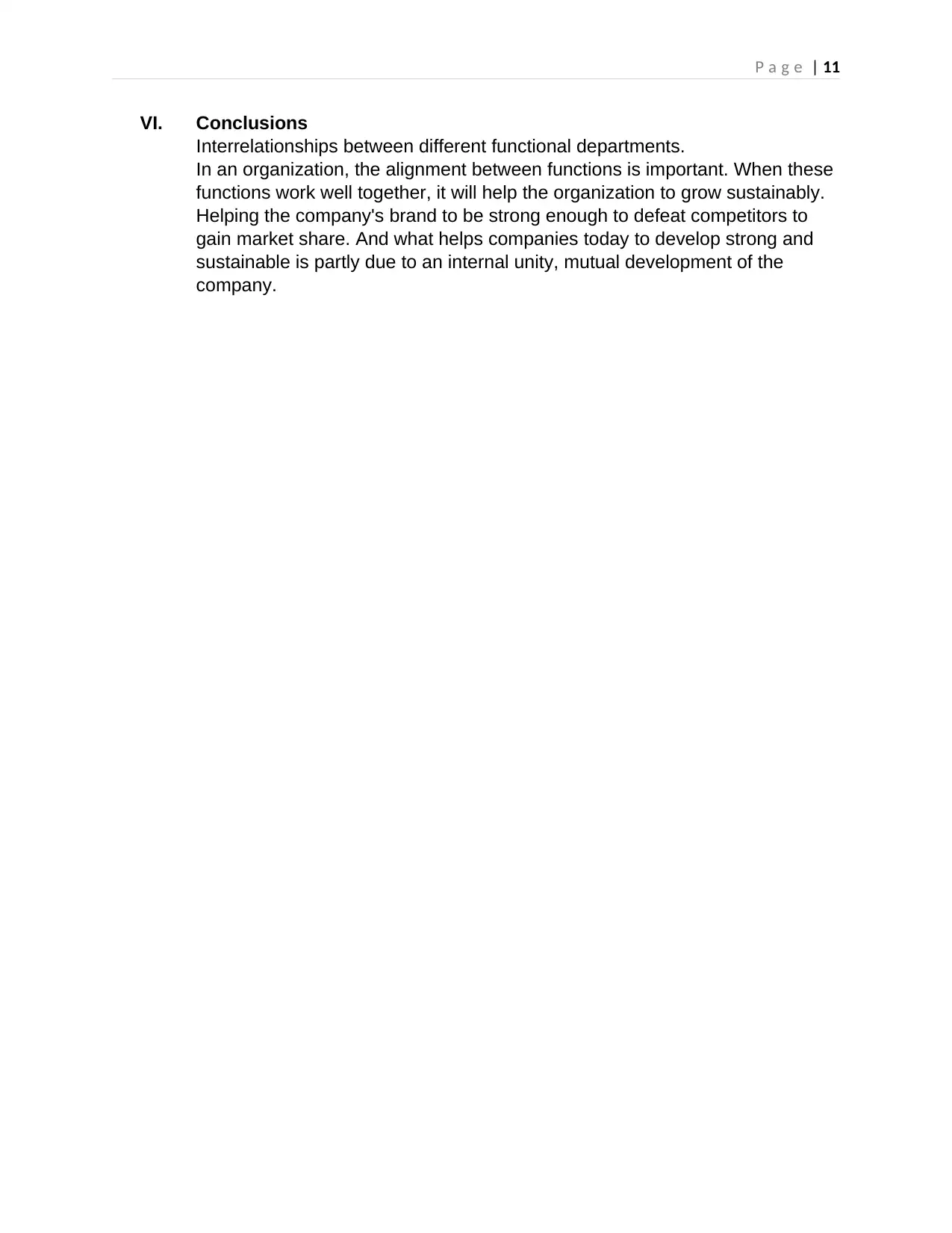
P a g e | 11
VI. Conclusions
Interrelationships between different functional departments.
In an organization, the alignment between functions is important. When these
functions work well together, it will help the organization to grow sustainably.
Helping the company's brand to be strong enough to defeat competitors to
gain market share. And what helps companies today to develop strong and
sustainable is partly due to an internal unity, mutual development of the
company.
VI. Conclusions
Interrelationships between different functional departments.
In an organization, the alignment between functions is important. When these
functions work well together, it will help the organization to grow sustainably.
Helping the company's brand to be strong enough to defeat competitors to
gain market share. And what helps companies today to develop strong and
sustainable is partly due to an internal unity, mutual development of the
company.
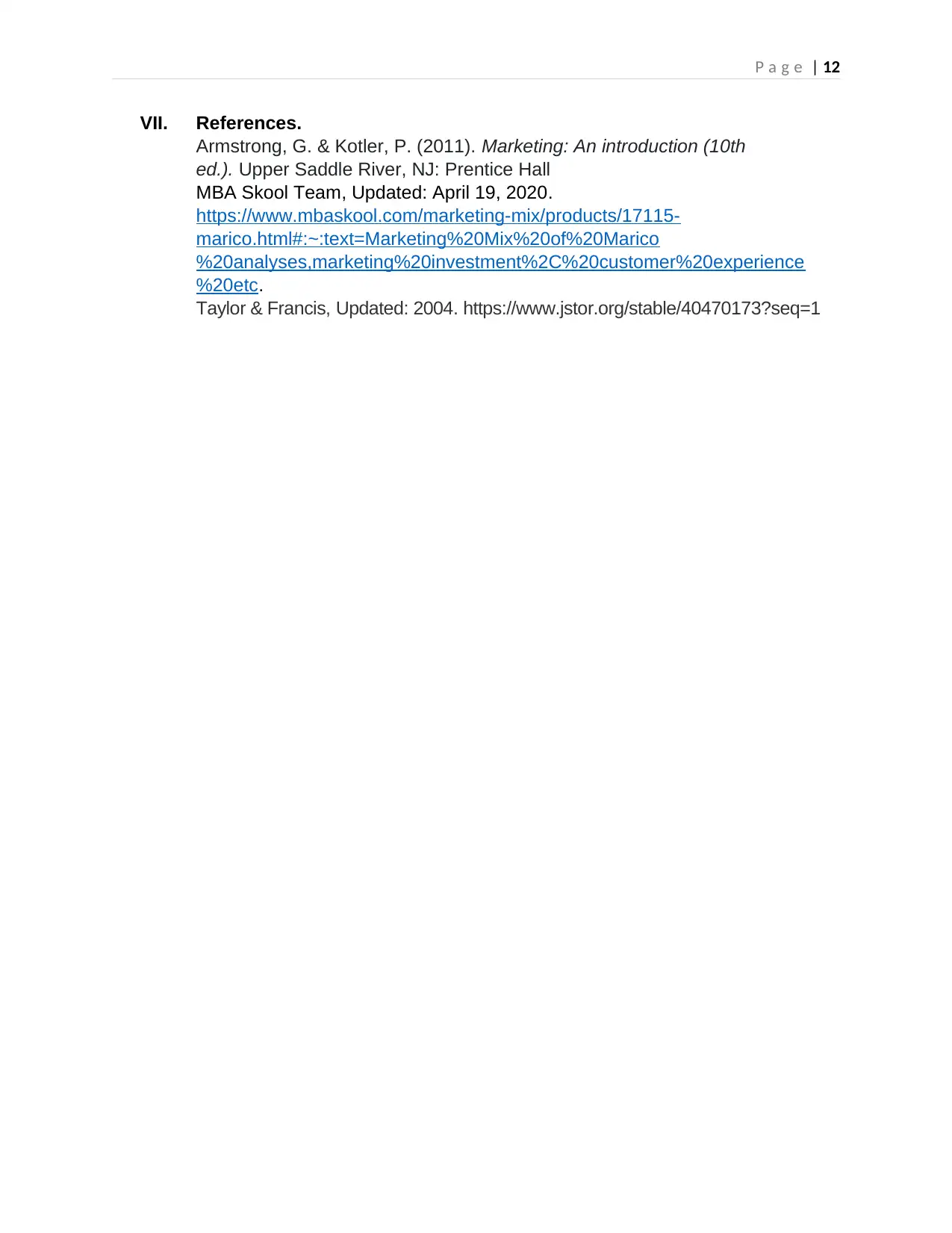
P a g e | 12
VII. References.
Armstrong, G. & Kotler, P. (2011). Marketing: An introduction (10th
ed.). Upper Saddle River, NJ: Prentice Hall
MBA Skool Team, Updated: April 19, 2020.
https://www.mbaskool.com/marketing-mix/products/17115-
marico.html#:~:text=Marketing%20Mix%20of%20Marico
%20analyses,marketing%20investment%2C%20customer%20experience
%20etc.
Taylor & Francis, Updated: 2004. https://www.jstor.org/stable/40470173?seq=1
VII. References.
Armstrong, G. & Kotler, P. (2011). Marketing: An introduction (10th
ed.). Upper Saddle River, NJ: Prentice Hall
MBA Skool Team, Updated: April 19, 2020.
https://www.mbaskool.com/marketing-mix/products/17115-
marico.html#:~:text=Marketing%20Mix%20of%20Marico
%20analyses,marketing%20investment%2C%20customer%20experience
%20etc.
Taylor & Francis, Updated: 2004. https://www.jstor.org/stable/40470173?seq=1
⊘ This is a preview!⊘
Do you want full access?
Subscribe today to unlock all pages.

Trusted by 1+ million students worldwide
1 out of 12
Related Documents
Your All-in-One AI-Powered Toolkit for Academic Success.
+13062052269
info@desklib.com
Available 24*7 on WhatsApp / Email
![[object Object]](/_next/static/media/star-bottom.7253800d.svg)
Unlock your academic potential
Copyright © 2020–2025 A2Z Services. All Rights Reserved. Developed and managed by ZUCOL.





